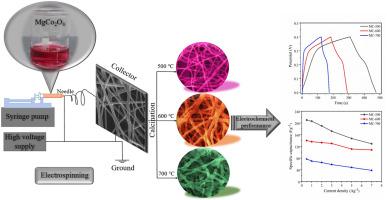Journal of Physics and Chemistry of Solids ( IF 4.3 ) Pub Date : 2021-01-30 , DOI: 10.1016/j.jpcs.2021.109981 M. Mahinzad Ghaziani , J. Mazloom , F.E. Ghodsi

|
Magnesium cobaltite (MgCo2O4) nanofibers have been prepared by a sol–gel electrospinning method. The effect of calcination temperature (500, 600, and 700 °C) on the physical properties of the product have been investigated by various techniques, such as TG/DTA, XRD, BET, FTIR, FESEM, EDS, and DRS. The XRD patterns indicated the co-existence of two phases of MgCo2O4 and MgO, and calcination at higher temperatures favored the MgCo2O4 spinel phase of the nanofibers. Optical studies have revealed that the band gap narrowed from 3.88 to 3.80 eV with increasing calcination temperature. The specific surface areas of the samples evaluated by the BET method concomitantly decreased from 34.65 to 6.48 m2 g−1 as the calcination temperature was increased from 500 to 700 °C. FESEM images revealed that calcination at higher temperatures interrupted the fiber structure and decreased the aspect ratio, ultimately leading to a rod-like morphology at 700 °C. The electrochemical performances of the MgCo2O4 electrodes have been assessed by cyclic voltammetry (CV), galvanostatic charge–discharge (GCD), and electrochemical impedance spectroscopy (EIS). According to the CV results, the maximum specific capacitance observed for the electrode material calcined at 500 °C was 324 F g−1 at a scan rate of 5 mV s−1, making it promising for application in pseudocapacitors. Moreover, the GCD results demonstrated that the sample calcined at 500 °C delivered a specific capacitance of 210 F g−1 at 0.5 A g−1 and that the capacitance retention was 87.80% after 3000 charge–discharge cycles at a current density of 3 A g−1, suggesting high cycling stability.
中文翻译:

电纺MgCo 2 O 4纳米纤维作为伪电容器应用的有效电极材料:煅烧温度对电化学性能的影响
钴镁(MgCo 2 O 4)纳米纤维是通过溶胶-凝胶电纺丝法制备的。煅烧温度(500、600和700°C)对产品物理性能的影响已通过各种技术进行了研究,例如TG / DTA,XRD,BET,FTIR,FESEM,EDS和DRS。XRD图谱表明MgCo 2 O 4和MgO两相共存,并且在较高的温度下煅烧有利于MgCo 2 O 4。尖晶石相的纳米纤维。光学研究表明,随着煅烧温度的升高,带隙从3.88 eV缩小到3.80 eV。随着煅烧温度从500℃升高到550℃,通过BET法评估的样品的比表面积从34.65降低到6.48m 2 g -1。FESEM图像显示,在较高的温度下煅烧会中断纤维结构并降低长宽比,最终导致700°C时呈棒状形态。MgCo 2 O 4的电化学性能电极已通过循环伏安法(CV),恒电流充放电(GCD)和电化学阻抗谱(EIS)进行了评估。根据CV结果,最大比电容在500煅烧电极材料观察℃下为324 F G -1以5毫伏s的扫描速率-1,使之成为有前途的伪电容器中的应用。此外,GCD结果表明,在500°C下煅烧的样品在0.5 A g -1下提供了210 F g -1的比电容,并且在电流密度为3的情况下经过3000次充放电循环后,电容保持率为87.80% g -1,表明高循环稳定性。










































 京公网安备 11010802027423号
京公网安备 11010802027423号